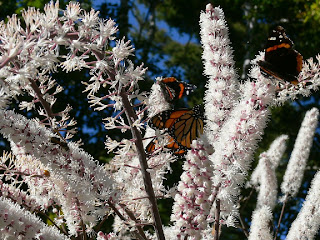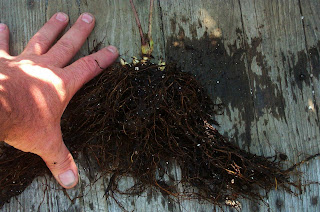
Sunday, March 30, 2008
A quarter of the moon is high over the tamaracks already on it's way to Montpelier, Camel's Hump and New York before it retires from sight until tonight. Following behind is the sun which hopefully will warm a 6 degree night into a nice day without wind for a change. Yesterday I took Alex to one of his programs in Jericho and at the base of the mountains in Underhill, the day had the personality of early January instead of "almost April". Not too nice!
We've had a series of family situations here at Vermont Flower Farm which have kept me away from many responsibilities. Gail's mother, Miriam, two weeks shy of 91 years old, has been very sick and has required Gail to be with her almost constantly. That need kind of rearranges life for other family members. Karl, the wonder dog, has been back to the "not too healthy" routine for a couple days so we have worries with him too. Fortunately Gail, Alex and I have been quite good, but tired through this. At times like these, I remind folks that lives, just like gardens, need a good plan. When you pass 50 years old, it's a very good time to sit back for a minute and figure out who's on first base and what's the plan to make it home.
I'm a contingency person, in the garden and in life. Everyone is not. It really is a good idea to think through what you will do with your parents as they need care. It's equally as important to consider each other and what happens if one of you falls ill and cannot continue on with the original plan. Many people chose to live by themselves and that poses even a different layer of challenges. I find that having a plan makes it easier to deal with unannounced challenges because you have had the opportunity to run things through your mind.
Gardeners and their gardens age together. Each year, gardeners write to listservs and ask for advice. They have spent years creating and collecting beautiful gardens and suddenly find that they can no longer continue on. It can be something as simple as the trip back and forth to the ground to plant or tend or weed that is just too painful a journey. What happens to the beauty of people or gardens may not be the same.
There isn't any book of answers here, just like Gail cannot turn to page 26 of Dealing With Mom With Compassion, to find a recommendation on handling her mother. There is no book by that title but if there was, people would turn to it I'm sure. The decisions are difficult. Sadly, sometimes gardens fall into the same category as old folks and there is a limited interest in being involved with them. Here at Vermont Flower Farm we have contingencies and just want you to think about yours too. It's good advice.
As if there's always time to get everything done, Gail returned home last night at 9:30 and almost before she finished with a snack, asked me how many cimicifugas we have for sale. This is the sign of too dedicated a gardener. I was struggling away at the new website and I do mean struggling. I had just finished writing the description for Hesperus, a great daylily from 1940 and I found it difficult to mentally switch gears to cimicifugas. But I did. Cimicifugas are high on my list just like Hesperus because they lend a strength to the garden people always look for.

When the conversation finished, we agreed that we had around 100 atropurpurea. These are the cultivar that eventually reach +9 feet tall even though most garden labels say "3 feet" We have about 20 Brunette, about the same number of James Compton and we have half a dozen Hillside Black Beauty that I really don't want to part with. Someplace here we have 40-50 Pink Spike which is another favorite.

Cimicifugas were reclassified a few years back and are now known as Actea. This is the same family as baneberry which some of you like. I've mentioned this before but continue to have difficulty making the name transition. Regardless of the name, these are great plants. Although they have a fairly shallow root system (above photo) it's a giant mass that holds tight to the ground. They do well in wet areas but seem to prosper on garden perimeters where half shade, thick organic matter and consistent moisture prevail. If you have visited Vermont Flower Farm before, you've had the opportunity to ask "What is that thing?" as we have a giant A. atropurpurea planted in full sun right next to the umbrella table we use as a check out. It will certainly exceed 10 feet this year!
To give you an example how A. atropurpurea fits into the garden, here are two shots I took at Maine Coastal Botanical Gardens in Boothbay, Maine last summer. Look to the right of the pine tree in the first photo and you'll see the white, bottle brush like bloom scapes. In the next photo you'll actually be looking through the scapes back towards the reception center there. This perimeter placement is an excellent use for these plants. If you are big on garden architecture, include these in your resource list.


The sun is rising and Gail just headed out to her mother's for the day. Alex is sleeping and Karl is stretched out in the sun on the floor next to the window. Looks like I am on my own for a while. Hope you have a nice day. All gardeners that read this don't have to wait for 3 feet to snow to melt before they can get excited. We still do!
Writing from the mountain above Peacham Pond where two red squirrels sit on the snow drift outside my window, front paws grasped together, waiting with great patience for me to get out there with more sunflower for the bird feeder. Praying squirrels??? Have to go........
George Africa
The Vermont Gardener
who is still reworking the VFF website, juggling family matters and trying to write at
Vermont Gardens once in while too. Today is a good day to think about placing an order!

4 comments:
George, I am so sorry for your mother in law's situation and the trying times for your wife and the rest of your family. We wish you all the strength to cope as best you can. The name changes of plants are exasperating to me, I have enough trouble just learning the names at all, then they get changed. We purchased a cimi last fall and placed it on the shady side of our hill, not the constant moisture they need, I know, but a place that needed a taller reddish foliage. It has returned after the winter and looks healthy enough. It won't reach ten feet tall, but that is probably a good thing. We are thinking of you.
Frances
Gorgeous pictures! I have been there, but muy pictures were not so good:D
Sorry, this was another comment, I can not understand how it has got here:(
Thank you for visiting my blog. I was reading yours and lots of things came up familiar to me- like snow, strong wind.I live on a peninsula, just in the middle of it, sea on the 2 sides. And if its not blowing from one side, it´s blowing from another. That´s why I have to keep to juniperus, rosa rugosa- plants, that are natural to my area. But I do love tropics! Cannas, bananas, palm trees- I have also those every summer in my garden, but it´s quite a hard job. By the way, I moved my trachycarpus fortunei outside already, inspide of cold nights!
George, hard times are always followed by good ones, so I wish you and your family a nice spring!
Mari, GardenJournalist from Estonia
Sadly we've had to care for my mother who has Alzheimer's so I can commiserate with your situation. Contingency plans are good as they become a necessity when life throws you a curve.
I thought cimicifugas were plentiful and easily obtained but apparently not so. We bought ours at a now defunct nursery where the owner grew almost all the plants he sold. I was surprised to find them listed in the Reserved Access section of the J.L. Hudson seed online catalog. This is their explanation: "Two types are reserved-access: rare, threatened, or endangered species, and seeds with prolonged, irregular, uncertain, or exacting germination requirements. To insure they reach experienced, qualified propagators, and to weed out "consumer-types", we reserve access to these seeds to those who:..."
Only after 5 years in ground did our plant produce a large flower spike with two smaller offshoots and a large seedhead in fall.
Post a Comment